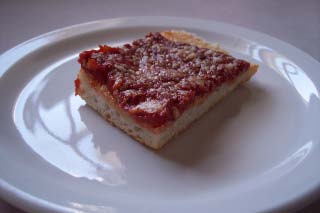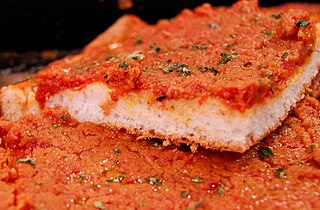Popularity
Brier Hill is Youngstown's best-known style of pizza. [7] It is not well-known outside of the area, but examples exist in Cleveland, Pittsburgh, and Columbus. [5] [6]
| Type | Pizza |
|---|---|
| Place of origin | Youngstown, Ohio |
| Created by | Italian Immigrants |
| Main ingredients | tomato pizza sauce, red and green peppers, Romano cheese |
Brier Hill-style pizza was developed by Italian immigrants in the Brier Hill neighborhood of Youngstown, Ohio. It is Youngstown's best-known style of pizza.
The pizza was developed in the Brier Hill neighborhood of Youngstown, Ohio. [1] The neighborhood takes its name from the nearby Brier Hill Farm estate of Ohio judge George Tod and former Ohio governor David Tod and the family's Brier Hill Iron & Coal Company. [1] [2] [3] The area was where Youngstown's first Italian immigrants settled in the late 1800s to find work in the steel mills. [1] [4]
They developed the style during the Great Depression as a use for extra bread dough. [1] It was originally baked in communal brick ovens. [1]
Brier Hill pizza is characterized by a breadlike dough, thick tomato sauce, bell peppers and Romano cheese rather than the more-typical mozzarella. [1] [4] [5] [6] The traditional toppings were used because home-canned tomatoes and peppers were common items in many Italian homes and Romano cheese can be stored without refrigeration. [6]
Brier Hill is Youngstown's best-known style of pizza. [7] It is not well-known outside of the area, but examples exist in Cleveland, Pittsburgh, and Columbus. [5] [6]

Pizza is an Italian dish typically consisting of a flat base of leavened wheat-based dough topped with tomato, cheese, and other ingredients, baked at a high temperature, traditionally in a wood-fired oven.

Chicago-style pizza is pizza prepared according to several styles developed in Chicago. It can refer to both the well-known deep-dish or stuffed pizzas and the lesser-known thin-crust "tavern-style" pizzas. The pan in which deep-dish pizza is baked gives the pizza its characteristically high edge, which provides ample space for large amounts of cheese and a chunky tomato sauce. Chicago-style deep-dish pizza may be prepared either this way or stuffed. Chicago-style thin-crust pizza dough is rolled for a thinner, crispier crust than other thin-crust styles, and the pizza is cut in squares instead of slices.

Calzone is an Italian oven-baked turnover, made with leavened dough. It originated in Naples in the 18th century. A typical calzone is made from salted bread dough, baked in an oven and stuffed with salami, prosciutto or vegetables, mozzarella, ricotta and Parmesan or pecorino cheese, as well as an egg. Different regional variations in or on a calzone can often include other ingredients that are normally associated with pizza toppings. The term usually applies to an oven-baked turnover rather than a fried pastry, although calzoni and panzerotti are often mistaken for each other.

Italian tomato pie is an Italian-American and Italian-Canadian baked good consisting of a thick, porous, focaccia-like dough covered with tomato sauce. It may be sprinkled with Romano cheese or oregano. It is not usually served straight from the oven, but allowed to cool and then consumed at room temperature or reheated. Like Sicilian pizza, tomato pie is baked in a large rectangular pan and usually served in square slices, although in Rhode Island it is cut into rectangular strips like pizza al taglio. Tomato pie descends from and resembles the Italian sfincione, although it is not the same dish. For instance, sfincione may have toppings, is usually served hot, and has a crust more like brioche than focaccia.

New York–style pizza is a pizza made with a characteristically large hand-tossed thin crust, often sold in wide slices to go. The crust is thick and crisp only along its edge, yet soft, thin, and pliable enough beneath its toppings to be folded to eat. Traditional toppings are simply tomato sauce and shredded mozzarella cheese. This was a popular meal among poor Italians due to the ratio of product from the limited produce.

Stromboli, also known as pizza arrotolata, is a type of baked turnover filled with various Italian cheeses and usually Italian cold cuts or vegetables, served hot. The dough used is either Italian bread dough or pizza dough. Stromboli was invented by Italian Americans in the United States, in the Philadelphia area. The name of the dish is taken from a volcanic island off the coast of Sicily.

Sicilian pizza is a pizza prepared in a manner that originated in Sicily, Italy. Sicilian pizza is also known as sfincione or focaccia with toppings. This type of pizza became a popular dish in western Sicily by the mid-19th century and was the type of pizza usually consumed in Sicily until the 1860s. It eventually reached North America in a slightly altered form, with thicker crust and a rectangular shape.
Brier Hill is a neighborhood in Youngstown, Ohio, that was once viewed as the city's "Little Italy." The neighborhood, which was the site of the city's first Italian settlement, stretches along the western edge of Youngstown's lower north side and encircles St. Anthony's Church, an Italian-American Roman Catholic parish. Each year, at the end of August, the Brier Hill Fest attracts thousands of visitors from Northeast Ohio and Western Pennsylvania.
The history of pizza began in antiquity, as various ancient cultures produced flatbreads with several toppings. Pizza today is an Italian dish with a flat dough-based base and toppings, with significant Italian roots in History.

The cuisine of New Jersey is derived from the state's long immigrant history and its close proximity to both New York City and Philadelphia. Due to its geographical location, New Jersey can generally be divided by New York City cuisine in the northern and central parts of the state and Philadelphia cuisine in the southern parts. Restaurants in the state often make use of locally grown ingredients such as asparagus, blueberries, cranberries, tomatoes, corn, and peaches. New Jersey is particularly known for its diners, of which there are approximately 525, the most of any state. Various foods invented in the state, such as the pork roll, and salt water taffy, remain popular there today.

Uruguayan cuisine is a fusion of cuisines from several European countries, especially of Mediterranean foods from Spain, Italy, Portugal and France. Other influences on the cuisine resulted from immigration from countries such as Germany and Scotland. Uruguayan gastronomy is a result of immigration, rather than local Amerindian cuisine, because of late-19th and early 20th century immigration waves of, mostly, Italians. Spanish influences are abundant: desserts like churros, flan, ensaimadas yoo (Catalan sweet bread), and alfajores were all brought from Spain. There are also various kinds of stews known as guisos or estofados, arroces, and fabada. All of the guisos and traditional pucheros (stews) are also of Spanish origin. Uruguayan preparations of fish, such as dried salt cod (bacalao), calamari, and octopus, originate from the Basque and Galician regions, and also Portugal. Due to its strong Italian tradition, all of the famous Italian pasta dishes are present in Uruguay including ravioli, lasagne, tortellini, fettuccine, and the traditional gnocchi. Although the pasta can be served with many sauces, there is one special sauce that was created by Uruguayans. Caruso sauce is a pasta sauce made from double cream, meat, onions, ham and mushrooms. It is very popular with sorrentinos and agnolotti. Additionally, there is Germanic influence in Uruguayan cuisine as well, particularly in sweet dishes. The pastries known as bizcochos are Germanic in origin: croissants, known as medialunas, are the most popular of these, and can be found in two varieties: butter- and lard-based. Also German in origin are the Berlinese known as bolas de fraile, and the rolls called piononos. The Biscochos were re-christened with local names given the difficult German phonology, and usually Uruguayanized by the addition of a dulce de leche filling. Even dishes like chucrut (sauerkraut) have also made it into mainstream Uruguayan dishes.

Lou Malnati's Pizzeria is an American Chicago-style pizza restaurant chain headquartered in Northbrook, Illinois. It was founded by the son of Rudy Malnati, who was involved in developing the recipe for Chicago-style pizza, and it has become one of the Chicago area's best-known local lines of pizza restaurants. Lou Malnati's operates a division of its company called Lou Malnati's Presents Tastes of Chicago, a partnership with Portillo's Restaurants and Eli's Cheesecake, which ships Chicago-style cuisine nationally.

Pizza arrived in the United States in the early 20th century along with waves of Italian immigrants who settled primarily in the larger cities of the Northeast, such as New York, Philadelphia, Boston, and Baltimore. After American soldiers stationed in Italy returned from World War II, pizza and pizzerias rapidly grew in popularity.

The traditional cuisine of Abruzzo is eclectic, drawing on pastoral, mountain, and coastal cuisine. Staples of Abruzzo cuisine include bread, pasta, meat, fish, cheese, and wine. The isolation which has characterized the region for centuries has ensured the independence of its culinary tradition from those of nearby regions. Local cuisine was widely appreciated in a 2013 survey among foreign tourists.

Iranian pizza also known as Persian pizza refers to the various styles of pizza and its preparation rather than its toppings. It is characterized by its thick bread and large amounts of cheese. Iranian pizza is served in Iran and places affected by the Iranian diaspora. It is usually made with minced meat, beef sausage, bell pepper, mushroom, mozzarella cheese, and Persian spices.

Argentine pizza is a mainstay of the country's cuisine, especially of its capital Buenos Aires, where it is regarded as a cultural heritage and icon of the city. Argentina is the country with the most pizzerias per inhabitant in the world and, although they are consumed throughout the country, the highest concentration of pizzerias and customers is Buenos Aires, the city with the highest consumption of pizzas in the world. As such, the city has been considered as one of the world capitals of pizza.

Fugazza con queso, or simply fugazza, is a common type of Argentine pizza, originating in Buenos Aires, that consists of a thick pizza crust topped with onions, cheese, and sometimes olives. It is derived from a combination of Neapolitan pizza with Italian focaccia bread.

Canada has many of its own pizza chains, both national and regional, and many distinctive regional variations and types of pizza resulting from influences of local Canadian cuisine.

Ohio Valley–style pizza is a pizza made with cold toppings sprinkled over a square crust that has been covered with a savory or sweet tomato sauce. It originated in Steubenville, Ohio and is served in parts of Ohio, Pennsylvania and West Virginia, mostly in and near the Ohio Valley region of those states.